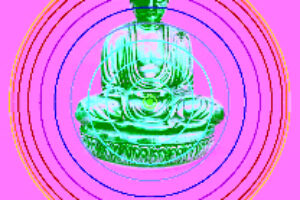
ANNUAL PRECEPTS RETREAT AND CONFERENCE IN JULY
As we approach the 6th Annual Conference of the Silent Thunder Order (STO) — held this year on Saturday, July 17th, 2016 — we invite you to plan to attend the Precepts Retreat that precedes it, beginning Wednesday the 13th.
But even if you are not taking the Precepts this year, the retreat represents an unusual, mid-summer opportunity for you to attend.
Several Zen priests of the STO, Practice Leaders of our Affiliate centers, will be coming to Atlanta as guest teachers during the week. They will give dharma talks each day, so you will be treated to different takes on the meaning of the first Five Buddhist Precepts, from a variety of personal perspectives.
The retreat begins with Wednesday evening arrival and orientation. It features early morning and evening meditations; a direct dialog on the Precepts, led by a guest teacher each afternoon, for retreat attendees; and a public talk, each evening of the retreat. If you cannot come for the entire retreat, you can attend morning and evenings, “bookending” your day with Zen. Or you may be able to attend only the public talks, each evening.
In any case, participate as much as you can in this once-a-year event, including the conference on Saturday. There, you will gain an overview of what the STO is, and how it serves our network of practice centers, including, especially, our training center, ASZC.
So all of these are reasons to plan to attend this retreat. But they are not the only, or most important reason. Other retreats do not have this kind of content-laden program.
HOW WE STRUCTURE OUR RETREAT PROGRAM
Let me go over our general approach to Zen retreats in the STO, and the reasons we conduct them the way we do. Other groups, representing other Zen lineages, may take a different approach; but, at base, all Soto Zen retreats represent an opportunity to deepen our practice, with a more intense emphasis on meditation, or zazen, than is afforded by regular, daily and weekly practice sessions. Zazen is the sine qua non of Soto Zen retreats.
At all STO retreats, we “taper on” with 25-minute sitting periods in the morning, broken by 5 minutes of walking meditation (J. kinhin). During the first period, we serve tea while facing inward (a tradition inaugurated by Chicago Zen Buddhist Temple, our historic home temple — over 60 years in operation). Then we introduce 50-minute sessions after breakfast; and 40-minute periods in the period after lunch, with 10-minute kinhin breaks. In the evening sessions, we “taper off,” returning to 25-minute sessions after supper.
The 25-minute sessions are familiar from our public day schedule, Sunday mornings. During newcomer training in Wednesday Workshop, we sit for even shorter times, usually ten or fifteen minutes. This comprises a reasonable program, we think, for individuals to approach zazen at their own rate, and to raise their own bar, as they become more experienced, and comfortable with longer sits. Zazen should be the “comfortable way.”
Following a similar logic, we have evolved three different kinds of retreats over time, informed by trial and error, which we characterize as “Buddha,” “Dharma,” and “Sangha.” The main difference between the three is the level of intensity of, or the time devoted to, “just sitting.” Another major difference consists in what the rest of the retreat schedule is dedicated to doing, or studying. The degree of social discipline that follows from each format also differs. Let’s look at each one in more detail.
BUDDHA RETREAT
The Buddha-style retreat is the simplest, and most intense, of the three formats. It is exemplified by our annual December retreat (J. Rohatsu), where we celebrate the historical Buddha’s Enlightenment. In this case, we dedicate the entire daily schedule primarily to sitting periods, from early morning (beginning at 5:00 or 6:00 am) to evening, usually ending at 9:00 pm. The last Saturday of the week, however, we sit up all night — 24 hours around the clock — in recognition of the tradition of Shakyamuni having done so. His profound Awakening is said to have transpired upon his seeing the morning star. For this reason, we usually sit outside that night, facing East, even when it is very cold. So it can be a challenge.
As one of our senior ASZC priests says, who has attended Rohatsu for several years, “Rohatsu — when ordinary misery just doesn’t cut it!” But not to worry, our other retreats are easier. You can work your way up to Rohatsu, over time.
DHARMA RETREAT
Dharma-style retreat is a little more laid-back, in terms of the amount of sitting on a daily basis, compared to Buddha-style. There is more time in the schedule, each day, for the study of Dharma, both through teachers’ talks, and study periods. Usually we offer one session each morning, and each afternoon of 60 to 90 minutes apiece. Where appropriate, an additional evening talk is given, to allow others who cannot attend during the day — owing to work and other responsibilities — to participate. Usually, the content for Dharma study is assigned, and other reading is discouraged. The topic is determined by the retreat teacher.
During Rohatsu, for comparison, discussion is allowed during only one period per day, mid-afternoon. It is in the form of a group dialog with the retreat teacher, rather than a talk, content limited to the experience that attendees are finding in their meditation.
In any retreat, another period may be slated during the day for one-on-one interviews (J. dokusan), which are not compulsory, but voluntary. They may replace the open discussion at the discretion of the retreat teacher. In which case, one might choose not to participate in any discussion, throughout the entire retreat. Another way of raising one’s own bar.
SANGHA RETREAT
A Sangha-style retreat, being oriented to community, would logically involve, and invite, more community interaction, than Buddha or Dharma retreats. Though the latter are also, obviously, supportive of Sangha. That is, if you become comfortable with the privations of a Buddha retreat, or the mind-numbing impact of a week bashing your head against the buddhadharma, in a Dharma retreat, you are much more likely to be a whole lot more patient with your peers, in a Sangha retreat. But there are no guarantees.
A Sangha-oriented retreat may emphasize — along with a respectable amount of zazen — discussions around the needs and concerns of the local community. Or they may involve some real hands-on work, “taking good care of the practice place,” the current cultural meme among the cognoscenti. Cleaning (J. soji) and maintenance (J. samu) are predictable staples on the Sangha sesshin agenda.
The ostensible function of the Sangha-style retreat may be expressed as fostering coherence of the community. But this is not to be understood as some kind of kumbaya moment, hazing ritual, or induction into a cult. Zen communities are, or should be, the opposite of a cult of personality. In a cult, one charismatic person, and/or his or her acolytes, present themselves as the go-to gurus for daily direction. They hold the secret keys to the overall meaning, intent, and purpose of the group. In Zen, we do the opposite. We train all who are willing, to be competent — to step up and step in, in the absence of the imputed leaders — to maintain the ongoingness of the operation.
What we offer in Zen is pretty simple in principle: we provide the space and time, and thus the opportunity, to practice meditation. This is the function and meaning of not only the leadership — historically the priesthood — but also of the community of practitioners, the Sangha. We inculcate a culture of service to the community for all our participants.
A retreat oriented to the community can be understood in this context of service to all. It represents an opportunity for a group of practitioners to come together in a more intensive cohort, a kind of hothouse environment, and practice together. This is a bit like creating the intentional communities of the 1960s and earlier — the much maligned communes — the obvious failures of which, in our history, should act as no deterrent to us in Zen. Our sanghas, however well constituted are, like clouds in the sky, temporary formations at best.
Whether you are attracted to the Buddha-, Dharma-, or Sangha-style retreat, we suggest that you consider going against your preference, and attending one, or all, of the others.
IMPOSED VS SELF-IMPOSED DISCIPLINE
As an important aside, in our STO lineage tradition, we approach all of the various aspects of Zen practice as essentially voluntary. For example, in our zendo, joining walking meditation (J. kinhin), when everyone else does, is entirely optional. If you are comfortable with continuing in zazen, it is fine with us. In this way, you may extend two 25-minute sessions to closer to an hour. We do not endorse the idea that all must conform, to all details of group movement; and we do not imply that to vary from the norm is an indication of ego-driven, or showing off, competitive “macho” Zen.
Of course, someone attending a retreat — or for that matter, living in residence at ASZC — who is not, obviously, following the schedule, something may be amiss. And that person may be asked to modify her or his behavior, or to leave. But we hold that the stronger Zen practice is to impose self-discipline, rather than having discipline imposed from outside.
THE KYOSAKU STICK
So, for example, we offer the traditional stick (J. kyosaku) for striking the shoulders, but you have to ask for it. If someone requests the stick, we feel it our obligation to oblige. Other groups have decided against this practice, and more power to them.
We also do not insist that our Affiliate Practice Leaders use the stick, though we encourage it, as did our Founder, Matsuoka Roshi. I make a stick for each Shukke Tokudo (Novice Priest) ceremony, as part of the certification. We only ask that any exceptions from our standards be announced, so that our members are not confused by different approaches. This goes to the central premise of Sangha, or community, practice — maintaining harmony.
OBSERVING SILENCE
Another example is the observance of silence. We do not enforce — but instead encourage — individual observance of silence at retreats. It is much more powerful for an individual to suddenly realize that they are the only one chattering away at a retreat. and self-consciously coming to observe silence; than for us to impose silence on attendees. It is also true, in our understanding of skillful means — that by our example, rather than via obiter dictum — we manifest the true meaning and value of observing silence.
FLEXIBLE MIND
Owing to our flexible approach, which allows for experimentation on the part of our retreat leadership, you may attend a retreat hosted by the STO that does not strictly conform to the formats outlined herein. But the retreat leadership will take pains to have you understand why, and, hopefully, before you register for the retreat. The main point we want to stress is that our retreats sponsored by STO may not be perfect. But then, in Zen, we are trained to accept imperfection, along with impermanence. And to have no anxiety over non-perfection.
We are participants in a kind of “guerilla Zen,” a situation in which we hit it and run; and survive to engage again. In doing so, we cultivate a truly liberal approach to community. We have the opportunity of establishing genuine community, a rarity in today’s “society.”
ZEN ATTACK
I have always maintained that it is a misnomer, to characterize what we engage in retreat (J. sesshin), as a “retreat”; it should be regarded as more of an “attack.” When we spend time on retreat, it may be true that we retreat from the distractions and seductions of everyday life. But in another, more compelling sense, we attack the very underpinnings of our delusions in daily life. If we can dedicate a day, a whole week, or even longer — to sitting upright in meditation — we can declare independence from our addiction to the blandishments of so-called civilization.
The most important reasons to engage in retreat have little or nothing to do with the content of the monologues and dialogues on offer as the “hook,” the theme, topic or title of the retreat. Although, in fairness, the words, and the encouragement, of the teachers are not to be dismissed. They are coming from a perspective of a deep, personal commitment to Zen, and having been there and done that, can offer sage direction to a newcomer or regular.
The single most important reason to attend a Zen retreat is that it is what you need. A Zen retreat represents a unique opportunity to disengage from the nonsense that the conventional wisdom insists is what is important. In the progress of a sesshin over several days, we are given the opportunity to discover, or rediscover, what is really important.
RE-ENTRY
One proof of this is that when we return from a retreat of sufficient intensity, we encounter a kind of “re-entry” problem, a phrase that emerged in the 1960s, associated with taking a psychedelic “trip,” and the inevitable crash that follows. In retreat, our normal defenses come down, leaving us raw and prickly. Returning to the commute, work, even the home environment, with all the distractions it entails, can be discomfiting and disorienting.
After sitting for some days on end — with no other demands on us, nothing special to do — our apprehension of our own reality shifts. The window of opportunity, with regard to insight, is a much bigger opening than usual. We no longer find ourselves thinking about or obsessing over what we could be doing, instead. We become unconcerned about what we may be doing this afternoon; or tomorrow. We will still be just sitting, here and now.
Once it becomes clear that we are not going to be doing anything substantively different than what we are doing in the present moment — later today, tomorrow, or later in the week — we settle into a different quality of time. The tendency of the mind to anticipate; to plan; to feel anxiety over the passing of time; diminishes. It is a bit like being incarcerated in prison, or in solitary confinement. Our ordinary, everyday concerns fade into irrelevance.
But when we have had the luxury of re-entering into real time — by virtue of the expedient means of a structured retreat — it can be very difficult, to acquiesce to being conscripted, back into the societal norm. Just when we thought we were all better, we are repelled by the specter of being sucked into conventional suffering, of insufferable custom.
RELATIVE AND ABSOLUTE LIBERATION
But this is not a reason to avoid attending retreat; just the opposite. The more we experience liberation from our normal perspective on reality, the more confidence we gain in redefining, and refining, our life. Because going on retreat suspends our usual day-to-day context and activity, we have that much greater opportunity to recognize our habitual patterns of behavior and thought, and to substitute new behaviors and habits. We can focus on right effort, right mindfulness, and right meditation, with greater continuity. This can help us establish a new normal mode of operation, which goes with us off the cushion; and has legs to stay with us, as we re-enter the hurly-burly fray of daily life. Finding liberation in the midst of life, rather than in escaping it. Retreat not from life, but into it. This is our true refuge — in Buddha, Dharma, and Sangha.








